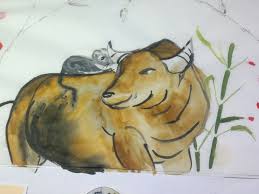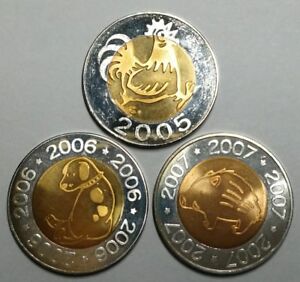
Farewell, Year of the Pig! 
Hello, Year of the Mouse!

In Western astrology (derived from early Babylonian star charts), your birth sign depends on when during the calendar year you were born. I happen to be an Aries. But the Chinese sign of the zodiac under which one is born depends upon the birth year (based on the Chinese lunar year). I happen to have been born under the sign of the Rooster. Many people in the US—most?—are more or less aware of such things.

Similarly, awareness that 2020 is a Rat year is relatively widespread. (Rat is often translated as Mouse in some countries, like Vietnam.) But not so many people are aware that Rat years aren’t all alike: 2020 is the year of the Metal Rat. Say what?! There is a Rat year every 12 years, but a Metal Rat year cycles every 60 years.
This is because the Chinese Five Elements (Metal, Wood, Water, Fire, and Earth) also cycle in order, so the alignment repeats every 60 years. The basic theory is that the zodiac sign characteristics are affected by/ interact with the elements. The Five Elements are used in Chinese medicine, philosophy, fengshui, fortune-telling, and martial arts.

Because they are less familiar to most Westerners, I’ll start with the qualities of the five elements:
- Wood-benevolence,
- Fire-propriety,
- Metal-righteousness,
- Water-wisdom,
- Earth-fidelity/honesty.
Traditionally, Metal is either silver or gold. In the West, people consider a gold year to come every 60 years. According the Chinese fortune-tellers, it’s once every 600.

The Chinese Five Elements are a bit like scissors/ paper/ rock in that no one element is always the strongest. In the controlling/ overcoming/ destruction/ restraining/ weakening interactions: Fire melts Metal, Metal chops Wood, Wood breaks up Earth, Earth absorbs Water, Water quenches Fire.
In the generating/ begetting/ engendering/ mothering/ enhancing interactions: Metal carries Water, Water nourishes Wood, Wood feeds Fire, Fire creates Earth/ash, Earth bears Metal.
How do the elements and signs of the zodiac interact? Each Chinese Zodiac Sign has a fixed element. This is the element that carries over from year to year. For the Rat, the fixed element is Water—and wisdom fits very well with the overall characteristics of Rats.

How do we get a metal rat? This year aligns a Metal year and a Rat year. A person’s characteristics are said to be determined both by the fixed element of their zodiac sign and the element of the year they were born in. Children born this year are supposed to have characteristics of Rats, Water, and Metal.
Characteristics of Rats – People born in the year of the Rat like saving and collecting. They are organized and financially secure. They tend to be parsimonious in terms of gift-giving. Rats don’t seek praise and recognition. They are sensitive, aware when there is trouble. When Rats take risks, they usually succeed. Add wisdom and, in 2020, righteousness.

Writers take note: consider drawing on the Chinese Zodiac and the related elements when characterizing your character. The traits often seem to be compatible.
How did the zodiac order come to be? In Western astrology, the astrological signs are based on constellations of stars that typically light the night sky during that month. They are ordered by the calendar year.
How did the Chinese zodiac years come to be Rat, Ox, Tiger, Rabbit, Dragon, Snake, Horse, Goat, Monkey, Rooster, Dog, and Pig in that order? According to chinahighlights.com, the story of the Chinese zodiac is much more entertaining. I’ll quote it here.

The Heavenly Gate Race Story — Reasons for Zodiac Rankings
Long, long ago, there was no Chinese zodiac. The Jade Emperor wanted to select 12 animals to be his guards. He sent an immortal being into man’s world to spread the message that the earlier one went through the Heavenly Gate, the better the rank one would have.
Early Risers: Quick-Witted Rat and Diligent Ox
Rat ranks first.

The next day, animals set off towards the Heavenly Gate. Rat got up very early. On his way to the gate, he encountered a river. He had to stop there, owing to the swift current. After waiting a long time, Rat noticed Ox about to cross the river and swiftly jumped into Ox’s ear.
The diligent Ox did not mind at all and simply continued. After crossing the river, he raced towards the palace of the Jade Emperor. Suddenly, Rat jumped out of Ox’s ear and dashed to the feet of the Emperor. Rat won first place and Ox was second.
Competitive and Fast: Tiger and Rabbit
Tiger and Rabbit came third and fourth because both are fast and competitive, but Tiger was faster. (Rabbit got across the river by hopping on stepping stones and a floating log.)

Good-Looking Dragon and Crafty Snake
Good-looking Dragon was fifth and was immediately noticed by the Jade Emperor, who said Dragon’s son could be sixth. But Dragon’s son didn’t come with him that day. Just then, Snake came forward and said Dragon was his adoptive father; so Snake ranked sixth.

Kind and Modest Horse and Goat

Horse and Goat arrived. They were very kind and modest and each let the other go first. The Jade Emperor saw how polite they were and ranked them seventh and eighth.
Jumping Monkey

Monkey had fallen well behind. But he jumped between trees and stones, and caught up to be ninth. Last were Rooster, Dog, and Pig.

These 12 animals became guards of the Heavenly Gate.
Why No Cat? — Enmity Between Cat and Rat
Although Cat and Rat were neighbors, the former always bullied the latter, and Rat felt very angry but dared not say it out loud; therefore, he sought revenge on Cat.
Upon hearing the Emperor’s decree Rat chuckled to himself and thought: “This is an opportunity”.

The sleepyhead Cat kicked open Rat’s door, ordering Rat to keep him informed of when he was going to the Emperor’s birthday party, and Rat readily promised that he would.
On the morning, however, Rat left quietly without informing Cat. Cat didn’t wake up until the race was over and it was too late — he was not able to make it into the cycle.
After the party, a great enmity grew between Cat and Rat, so that rats scatter in all directions when a cat appears.
An alternative version of the story says that Cat and Rat got as far as crossing the river together on Ox’s head, but Rat pushed Cat into the water (and Cat was washed away and drowned or didn’t get back to the Heavenly Gate in time to get a ranking).
People’s Personal Traits

The ranking story above is made up according to people’s understanding of characteristics of the 12 animals. And when people talk about a person’s zodiac sign, they might think about the zodiac sign’s characteristics.
For example, when talking about Rats, people think of quick-witted, resourceful, and versatile people. Oxen are decisive, honest, dependable, and hardworking. There is a wealth of information available online about every aspect of life suggested for each sign, including careers, colors, numbers, flowers, education, and just about anything else a writer might use.

People born under certain zodiac animal signs are also assumed to have varying levels of compatibility with other signs. This goes beyond simple romantic relationships; like the balance of the five elements, each animal offers something different to each other animal. A friend of mine had a daughter in the year of the Fire Monkey and insisted that her sister-in-law (an Earth Rat) was the first person to hold the baby. Rats provide wisdom and guidance to Monkeys, tempering some of their more negative qualities.
How to Behave During Chinese New Year
According to chinesenewyear.net, there is a whole raft of taboo behaviors during this time. The majority of these taboos stem from an overall belief that the year will continue as started – whatever you are doing at the beginning of the year, you will be doing the whole year long. In 2020, Chinese New Year falls on January 25th and the festival will last till February 8th, about 15 days. Good luck observing all of these taboos for two weeks!

- Do not say negative words.
- Do not break ceramics or glass.
- Do not clean or sweep.
- Do not use scissors, knives or other sharp objects.
- Do not demand debt repayment.
- Avoid fighting and crying.
- Avoid taking medicine, visiting the doctor, perform/undergo surgery, get shots.
- Do not give New Year blessings to someone still in bed.
Writers note: Breaking these taboos could be a source of tension between characters. The lengths a character goes to in order to avoid these taboos could make for interesting tension.

Red is considered a lucky color almost everywhere Chinese New Year is celebrated, especially red envelopes. Adults hand out lucky money to children (and sometimes elders) in special red envelopes. Crisp, clean, new bills straight from the bank are preferred, always in an odd number. In America, $2 bills are especially prized!
Because of the Chinese diaspora, the Lunar New Year is celebrated in many countries with large populations of people with Chinese heritage (including America!) Many of these countries have their own traditions and taboos while celebrating. Here are a few examples of different customs:

- Vietnam – Tết Nguyên Đán
- Celebrations follow the same lunar calendar used for Chinese New Year but usually only last for three days.
- Family is a primary focus of celebrations, including offerings to ancestors, visiting elders and other family members. and tending to family graves. The first day of festivities is usually reserved for family gatherings.
- Lion dances, setting off fireworks, displays of symbolic fruits and flowers, and “Chinese Markets” are common public forms of celebrating.

- Mongolia – ᠴᠠᠭᠠᠨ ᠰᠠᠷᠠ (Tsagaan Sar)
- Specific methods of celebrating vary widely among regions
- White is a very lucky color at this time (Tsagaan Sar literally translates as “white moon”): people ride white horses, exchange white gifts, and eat white foods made from dairy
- Honoring elders and making sincere reconciliations with anyone wronged figure prominently in every community
- Piles of food!

- Korea – 설날 (Seollal)
- Family is the main focus of most celebrations
- Because so many Koreans travel home to be with family on Seollal, airports, train stations, etc. are extremely busy
- Before they can receive their red envelopes with lucky money, children must perform a full traditional Korean bow to their elders
- Korean festivities are much quieter than many other countries celebrating the Lunar New Year, centered around family

- Tibetan Buddhism – ལོ་གསར་ (Losar)
- Losar celebrations vary according to regional differences in Buddhist practices
- The holiday is often celebrated with prayer and temple visits
- Decorations incorporate Buddhist signs, such as the Eight Auspicious Symbols marked on walls
- The first three days of Losar focus on specific devotions: Lama Losar – dharma teachers and gurus; Kings Losar – community and national leaders, the Dalai Lama offers greetings and blessings to other national leaders; Choe-kyong Losar – gods and divine protectors
- Less formal festivities often continue until Chunga Choepa, the Butter Lamp Festival, 15 days after Choe-kyong Losar

